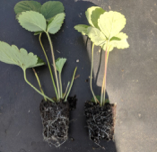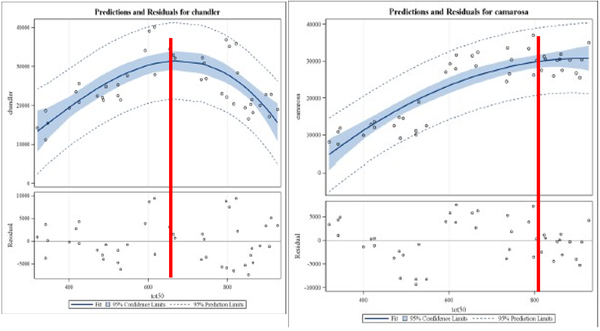Planting date, pre-plant soil and bed preparation, and plant quality are the three important pillars that make the foundations for a successful crop.
In this guide, we will describe what to do before and after a late planting, as well as how to use floating row covers to improve growing degree days and plant growth.
Planting windows for strawberry grown in annual hill plasticulture can vary by the region and are provided in Table 1.
| State
|
Sub-Region
|
Recommended Strawberry Planting Date Range
|
Notes
|
|---|---|---|---|
| Arkansas
|
Northern
|
September 10 -20
|
Growers at higher elevations should plant on the earlier side of the recommended range.
|
| Central
|
September 20-Oct 1
|
||
| Southern
|
September 25-October 8
|
||
| Alabama
|
|
October 1-15
|
Growers in northern part of the state should plant closer to Oct 1.
|
| Louisiana
|
Southeast
|
October - Early November for bareroot plants
|
|
|
|
Late September for early plug plant production
|
||
| North Carolina
|
Mountains
|
1st week of September
|
Dates listed are for ‘Chandler’ and ‘Camarosa’. Bareroot plants should be set 3-5 days earlier than plugs.
|
| Foothills
|
3rd week of September
|
||
| Upper Piedmont/ Tidewater
|
4th week of September-1st week of October
|
||
| Lower Piedmont/ Coastal Plains
|
1st – 2nd week of October
|
||
| Lower Coastal Plain
|
2nd week of October
|
||
| Virginia
|
Mountains
|
Early September
|
|
| Upper Piedmont, Northern
|
Mid-September
|
||
| Southeast, Coastal
|
Late September to first week in October
|
Growers across the region have experienced a delay in receiving plant material this year due to a multitude of reasons including labor issues in nurseries, shipping and supply chain holdups, or simply not enough availability. In addition, Hurricane Fiona hit eastern Canada during one of the busiest times for nurseries. Rain events in some areas or prolonged drought in others have led to a delay in soil and bed preparation in many states in the southern U.S.
The good news is: There is still time to enhance plant growth, even if you are a few weeks late on planting. Increasing growing degree days (GDD) by using floating row covers in the fall is one of tools a grower has in their toolbox to mitigate some of the problems of a late planting date. However, it is important to recognize differences between cultivars before deciding if a row cover is needed.
Cultivars such as Sweet Charlie or Chandler have lower GDD requirements. Other cultivars, such as Camarosa, Ruby June or Camino Real require more GDDs. If you are late in planting the latter cultivars, the application of floating row covers in fall to improve GDDs is an option to consider. Below are details that we encourage a grower to pay attention to, during the planting season.
1. Before planting
| The Dos
|
Order 5% excess plants; Check plants for diseases before planting; Only plant disease-free plants with established root systems;
|
|---|---|
| The Don’ts
|
Don’t plant plants with clear disease symptoms. Don’t plant plants with a weak root system.
|
Even with a late planting, it is still absolutely important to screen your plants when they arrive. If plants appear to be weak, it can be a simple nutrition problem. But it also could be a weak root system or a disease problem. We recommend cutting the crowns of weak appearing plug plants and search for reddish-brown discoloration (Figure 1). Such discoloration could point to diseases such as Phytophthora crown rot. We also recommend looking for brown leaves, crisp leaves, blackish lesions and an unusual amount of leaf spots (Figure 1). That could point to a host of different diseases, from Angular Leaf Spot to Neopestalotiopsis. The second trait you want to screen is the root ball. A well-established root ball and a good crown are extremely important for a successful use of plug plants.
- (Figure 2a): Well-established plug plants and cut-offs have a full root ball and a crown that is above the substrate (picture by B. Poling).
- (Figure 2b): Poorly developed plug plants show weak root systems and/or a crown that is buried under the substrate surface. The particular picture shows both.
- (Figure 2c): Tips that were stuck when they were too old show two-three leaflets, but no root system.
The more and more popular tray-plants should also have well-developed root balls, and possibly two crowns. Bare-root and cut-off plants should have well-developed fibrous roots.
We do not recommend planting any weak material, even if you plan to use row-covers to increase GDDs. Your order should contain about 5% more plants that you intend to use.
Keep your plug plants under a sprinkler for a few days before planting. Make sure that suspicious trays are being stored separately from the other trays and that water can run off separately as well. You can avoid a lot of hardship by selecting your planting material in the first place.
2. At Planting time:
| The Dos
|
Plants at the correct depth. Water plants in after transplanting. Screen your plants for disease and nutrition disorders. Control for Botrytis gray-mold, Anthracnose, Phytophthora crown rot and other foliar diseases.
|
|---|---|
| The Don’ts
|
Do not walk away after planting!
|
Plug- and bare-root plants need to be planted at the crown level. Strawberry transplants are very unforgiving if it comes to the wrong planting depth. That means, that the root ball of a plug plant and the roots of a bare-root plant need to be covered and have good soil contact, while the crown needs to be above ground. If plants are planted too shallow or too deep, plants will most likely underperform or even die. Train your workers how to plant plants.
The hole for a plug plant should be a little less than the size of the rootball. Usually, plug plants come in a 50-cell tray with a 2 ¼ to 2 ½ inch root ball. The ideal depth for a planting hole is 2 ¼ - 2 inches deep, so that plug plants can gently be pressed against the soil for good soil-root contact. After successful planting, the rootball should be slightly covered with soil, at low to mid-crown level.
For more information, please see the Strawberry Production Planting Guide.
After planting, make sure to monitor your strawberry field and remove any plants that show disease symptoms or weak growth in the first two weeks after planting. To identify diseases, please follow the links below.
- Anthracnose crown rot
- Anthracnose fruit rot
- Grey mold/ botrytis crown rot
- Phytophthora crown rot
- Neopestalotiopsis
Many apply water, either through the drip line or through sprinklers for the first two to three days. Go through your field and sanitize crispy leaves, discolored leaves and cut runners during the first week. Apply a fungicide with Phytophthora activity (e.g. Rodimil Gold) through the drip line in the first two weeks and make preventative fungicide applications against Anthracnose, Botrytis and Neopestalotiopsis. We highly recommend to also refer to the newest version of the Southern Regional Strawberry Integrated Pest Management Guide.
3. After Planting: Correct use of floating row covers to enhance floral initiation
| The Do’s
|
Use row covers October until end of November for 2-3 weeks max.; Control for diseases before applying row covers and again after taking them off. Measure temperatures under row cover and calculate GDDs!
|
|---|---|
| The Don’ts
|
Don’t use row-covers without calculating the GDDs in your area! Don’t walk away without disease control after row covers use.
|
Research in NC suggests optimal GDDs for ‘Chandler’ in Fall are around 630 GDDs, while the optimal GDDs for ‘Camarosa’ are around 800 GDDs. (Figure 3). (after Pattison et al. 2013). Based on these results ‘Chandler’ will not need additional row-cover use. However, research in Arkansas has found that row-cover application to Chandler can be useful in years where the weather turns cold very early.
GDDs in fall are decisive for floral initiation in traditional short-day cultivars. Research has shown that the planting date is the most important factor to affect the number of crowns in spring. The use of floating row covers to optimize GDDs however can have a positive effect on the number of inflorescences per branch crown. We say ‘optimize’, because you also can provide too many GDDs. This is especially true for Chandler or Sweet Charlie, which need less GDDs for an optimal harvest.
The use of floating row covers in fall can help make up for some of the GDD lost due to a late planting date, however research in Arkansas consistently shows that row covers applied to late plantings cannot completely make up for the lost time. Additionally, fall row cover use makes the most sense if cooler temperatures are expected. In some exceptional years where the weather stays warm well into fall, enough GDDs will be provided during fall without the use of covers. We recommend to ALWAYS calculate GDDs (Table 5) based on the predicted weather before using floating row covers. Use light weight (0.5-0.75 oz) row covers, for maximum of 2-3 weeks between October and end of November!
Additional work in Arkansas is underway to verify the GDD requirement for additional cultivars. The rule of thumb used in Arkansas has been to apply row covers a few weeks after planting if the daily high temperatures are predicted to remain below 65°F.
4. Additional Resources:
Calculate Growing Degree Days in NC
Publication date: Nov. 23, 2022
Recommendations for the use of agricultural chemicals are included in this publication as a convenience to the reader. The use of brand names and any mention or listing of commercial products or services in this publication does not imply endorsement by NC State University or N.C. A&T State University nor discrimination against similar products or services not mentioned. Individuals who use agricultural chemicals are responsible for ensuring that the intended use complies with current regulations and conforms to the product label. Be sure to obtain current information about usage regulations and examine a current product label before applying any chemical. For assistance, contact your local N.C. Cooperative Extension county center.
N.C. Cooperative Extension prohibits discrimination and harassment regardless of age, color, disability, family and marital status, gender identity, national origin, political beliefs, race, religion, sex (including pregnancy), sexual orientation and veteran status.





